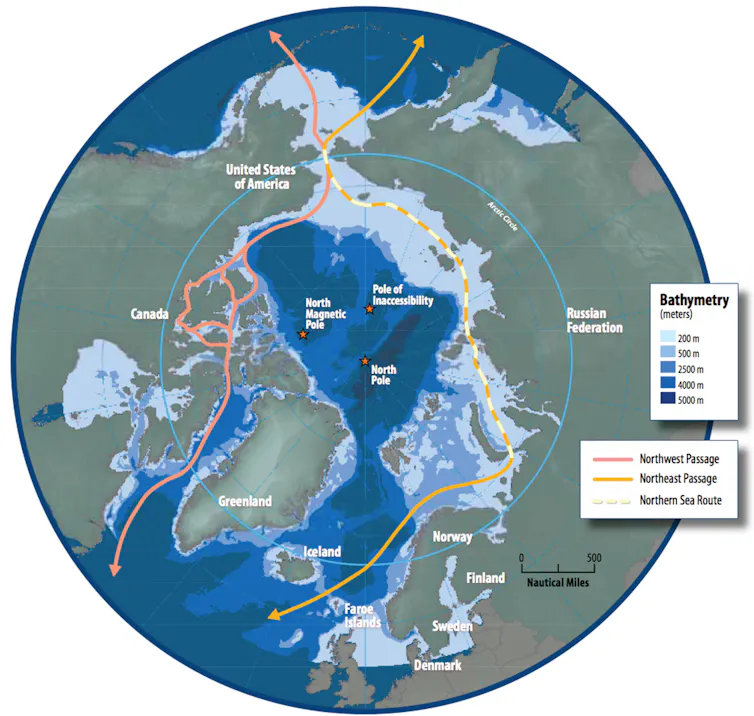Attacks by Yemeni Houthi rebels on merchant ships in the Red Sea have hit world trade. Between November and December 2023, the number of containers travelling through the Red Sea each day fell by 60% as ships moving goods between Asia and Europe diverted their routes around the Cape of Good Hope at the southern tip of Africa.
This route results in at least ten days more sailing time, so has caused freight prices to surge and has triggered costly delays to production. The region has become a bottleneck for the global economy before. The Suez canal, a waterway that connects the Mediterranean Sea to the Red Sea, was blocked for six days in 2021 after a container ship called the Ever Given ran aground, disrupting billions of dollars worth of trade.
The cape route has been used each time passage through Suez has been disrupted. But there is an alternative sea passage between Asia and Europe – the Northern Sea route.
This route, which runs from the Barents Sea near Russia’s border with Norway, to the Bering Strait between Siberia and Alaska, may be a better option and will soon become available if global warming continues at the predicted rate. Nevertheless, it currently faces many challenges.
Europeans, get our weekly newsletter with analysis from European scholars

An alternative for world trade?
Research estimates that summer sea ice around the Siberian coast will be melted completely by 2035. Even if ice cover is not completely removed, the thickness of the sea ice – one of the initial barriers to Arctic shipping – has significantly reduced over the past four decades from 3.64 metres to 1.89 metres. Arctic navigation is thus expected to be viable by the beginning of the next decade.
For shipments between Shanghai and Rotterdam, the Northern Sea route reduces the distance that ships will need to travel by around 3,000 nautical miles compared to Suez and 6,200 miles compared to the cape route. This would reduce the amount of time if takes to sail between eastern Asia and northern Europe to 18 days (it currently takes 32 days via Suez).
Arctic navigation is also performed at very slow speeds – under 18 knots (roughly 21mph). So, depending on sailing speed and the type of fuel used, a cargo ship that passes through the Northern Sea route could use 40% less fuel and generate up to 80% fewer emissions than if it used the Suez route.
But is it viable?
Despite its advantages, Arctic navigation is highly seasonal, restricted to the months between July and November. Navigating ships through the Northern Sea route also requires an escort behind a nuclear-powered icebreaker ship. But the number of icebreakers is limited. Just five operated on the Northern Sea route in 2021, rising to nine by 2030.

The Northern Sea route also suffers capacity issues. So-called “mega-vessels” that have a capacity of around 20,000 containers are deployed for trade between Asia and Europe. However, the Northern Sea route is not able to accommodate mega-vessels due to the imposition of restrictions based on the depth of sea ice.
Nowadays, only vessels with a roughly 5,000 container carrying capacity can easily navigate through the North Sea route during the summer.
Fragile Arctic ecosystems
Cargo ships that pass through the Northern Sea route would potentially generate fewer carbon emissions than ships that travel through Suez. But this alternative route is subject to other environmental challenges.
Arctic ecosystems take a long time to recover from disturbances like oil spills. Accidents in these sensitive regions may thus cause unimaginable marine pollution.
In 1989, for example, the Exxon Valdez oil tanker ran aground in Prince William Sound, Alaska, spilling more than 250,000 barrels of oil into the sea. The oil spill killed billions of salmon and more than 300,000 animals from a variety of fish and bird species.
More than 25 years since the spill, four of these species (killer whales, Kittlitz’s murrelets, marbled murrelets and pigeon guillemots) have not been re-encountered in the region.
Many cargo ships also carry ballast water to maintain stability during various stages of their operation. Ballast water is taken on or discharged throughout the ship’s journey. This practice could potentially result in the migration of invasive species to the unique Arctic ecosystem.

Routes are changing
Despite these challenges, Arctic shipping traffic is increasing. Between 2013 and 2017, the volume of cargo traffic on the Northern Sea route rose from 2.8 million tons to 10.7 million tons.
In 2023, this had grown to 36.2 million tons. And it shows no signs of slowing down. In 2024, Russia’s icebreaker fleet expects to conduct 1,747 escorts (up from 1,218 in 2023).
The Northern Sea route is currently not able to accommodate the vessel traffic and amount of cargo that passes through the Suez Canal. But it could be a viable alternative in the future depending on how fast progress is made on tackling global warming and developing a regulatory framework for navigating the Arctic region.





Fantastic beat I would like to apprentice while you amend your web site how could i subscribe for a blog site The account helped me a acceptable deal I had been a little bit acquainted of this your broadcast offered bright clear concept
Somebody essentially lend a hand to make significantly posts I might state That is the very first time I frequented your web page and up to now I surprised with the research you made to create this particular put up amazing Excellent job
It’s important to consider all options for maintaining smooth trade and transportation operations. This is a great suggestion for improving future logistics strategies.